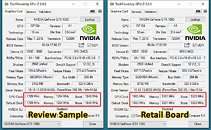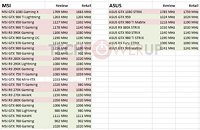Thursday, June 16th 2016
MSI and ASUS Send VGA Review Samples with Higher Clocks than Retail Cards
MSI and ASUS have been sending us review samples for their graphics cards with higher clock speeds out of the box, than what consumers get out of the box. The cards TechPowerUp has been receiving run at a higher software-defined clock speed profile than what consumers get out of the box. Consumers have access to the higher clock speed profile, too, but only if they install a custom app by the companies, and enable that profile. This, we feel, is not 100% representative of retail cards, and is questionable tactics by the two companies. This BIOS tweaking could also open the door to more elaborate changes like a quieter fan profile or different power management.
MSI's factory-overclocked GeForce GTX 1080 Gaming X graphics card comes with three software-defined clock-speed profiles, beginning with the "Gaming Mode," which is what the card runs at, out of the box, the faster "OC mode," and the slower "Silent mode," which runs the card at reference clock speeds. To select between the modes, you're expected to install the MSI Gaming software from the driver DVD, and use that software to apply clock speeds of your desired mode. Turns out, that while the retail cards (the cards you find in the stores) run in "Gaming mode" out of the box, the review samples MSI has been sending out, run at "OC mode" out of the box. If the OC mode is how the card is intended to be used, then why make OC mode the default for reviewers only, and not your own customers?Above, you see two GPU-Z screenshots, one of the TPU review sample, next to the retail board (provided by Nizzen). Flashing the retail BIOS onto our review sample changed the clocks to match exactly what is shown on the GPU-Z retail screenshot.
In case of the GTX 1080 Gaming X, the "Gaming mode" runs the card at 1683 MHz core and 1822 MHz GPU Boost; and the "OC mode" runs it at 1708 MHz core and 1847 MHz GPU Boost. The cards consumers buy will run in the "Gaming mode" out of the box, which presumably is the default factory-overclock of these cards, since they're branded under the "Gaming series."The "OC Mode" is just there so consumers can overclock it a little further at the push of a button, without having any knowledge of overclocking. Now if the OC mode is enabled for review samples of one company and not for the others, this means that potential customers comparing reviews will think one card performs better than the other, even if it's just 1%, people do base their buying decision on such small differences.
With the case of the GTX 1080 at hand, we started looking back at our previous reviews and were shocked to realize that this practice has been going on for years in MSI's case. It looks like ASUS has just adopted it, probably because their competitor does it, too, "so it must be ok."It's also interesting to see that not all cards are affected, whether this is elaborate or by accident is unknown.
While we don't have any statements of the companies yet, the most likely explanation is that reviewers usually don't install any software bundled with the graphics card, yet the companies want the cards to be tested in OC mode, which provides higher performance numbers, beating their competitors. That's probably how this whole thing started, nobody noticed and the practice became standard for reviews moving forward.
This issue could affect upcoming custom GeForce GTX 1070 review samples too, we will be on the lookout.
MSI's factory-overclocked GeForce GTX 1080 Gaming X graphics card comes with three software-defined clock-speed profiles, beginning with the "Gaming Mode," which is what the card runs at, out of the box, the faster "OC mode," and the slower "Silent mode," which runs the card at reference clock speeds. To select between the modes, you're expected to install the MSI Gaming software from the driver DVD, and use that software to apply clock speeds of your desired mode. Turns out, that while the retail cards (the cards you find in the stores) run in "Gaming mode" out of the box, the review samples MSI has been sending out, run at "OC mode" out of the box. If the OC mode is how the card is intended to be used, then why make OC mode the default for reviewers only, and not your own customers?Above, you see two GPU-Z screenshots, one of the TPU review sample, next to the retail board (provided by Nizzen). Flashing the retail BIOS onto our review sample changed the clocks to match exactly what is shown on the GPU-Z retail screenshot.
In case of the GTX 1080 Gaming X, the "Gaming mode" runs the card at 1683 MHz core and 1822 MHz GPU Boost; and the "OC mode" runs it at 1708 MHz core and 1847 MHz GPU Boost. The cards consumers buy will run in the "Gaming mode" out of the box, which presumably is the default factory-overclock of these cards, since they're branded under the "Gaming series."The "OC Mode" is just there so consumers can overclock it a little further at the push of a button, without having any knowledge of overclocking. Now if the OC mode is enabled for review samples of one company and not for the others, this means that potential customers comparing reviews will think one card performs better than the other, even if it's just 1%, people do base their buying decision on such small differences.
With the case of the GTX 1080 at hand, we started looking back at our previous reviews and were shocked to realize that this practice has been going on for years in MSI's case. It looks like ASUS has just adopted it, probably because their competitor does it, too, "so it must be ok."It's also interesting to see that not all cards are affected, whether this is elaborate or by accident is unknown.
While we don't have any statements of the companies yet, the most likely explanation is that reviewers usually don't install any software bundled with the graphics card, yet the companies want the cards to be tested in OC mode, which provides higher performance numbers, beating their competitors. That's probably how this whole thing started, nobody noticed and the practice became standard for reviews moving forward.
This issue could affect upcoming custom GeForce GTX 1070 review samples too, we will be on the lookout.



162 Comments on MSI and ASUS Send VGA Review Samples with Higher Clocks than Retail Cards
As I said, MSI was doing this since 780 days also, so no big surprise here...
I think Linus Torvalds would like to have a word with you. :) Pretty sure I can manually set any clocks I want by using aticonfig on the command line without any hassle.
I just find it funny how TPU just decided to whine about this now when my 390 GAMING works the same exact way.
Video of Torvalds publicly telling nVidia, "f**k you."
i am sure i read other reviews in the past stating they had review versions but didn't release reviews till they had checked the retail cards matched.
the fake nature of the whole review system is something most people choose not to talk about. how many reviewers turn round and say the things they were given, for free, before they became available to buy were shit? not many will tell the truth for risk of rocking the boat regardless of the product.
the fact that anybody is willing to hold the system up to the light is commendable imo.
In Summary: There is zero need to install the Gaming app to hit any of the listed speeds.
www.pcper.com/news/Cases-and-Cooling/ASUS-Responds-GTX-1080-Reviewer-VBIOS-Concerns
And since the review sample can run the oc mode by default already, then why not the consumers cards also?
In any case, a review should show what a product can do, therefor it needs to be exactly the same as the retail product.
ps I don't use the gaming app either.
All you need to do is go to our BIOS database and download the BIOS from the review card, flash it, and you'll have the same thing. That applies to both the ASUS and MSI cards, and pretty much every single card every reviewed here on TPU.
(PCPartner company)
They don't even see what's wrong with it, they just admit and provide argumentation with it. Wow. It's like they're saying, hey stupid consumer, listen, we know what's best for you. Now shut up and buy PLS, you think too much.
Ill still happily get an MSI gaming 1070. I wont use their gaming app, but instead afterburner and set my own clocks and profiles.
While everyone is crying about this stuff, ill be playing games and enjoying every second of it.
Well, this is something I do not expect average users to understand. Either way, MSI and ASUS GTX 1080/1070 will be just as good as the others but the proven fact (which they already admit by now) that:
Sample Cards ≠ Retail Cards
means
1) false advertising
2) elaborate setup to fool users/reviews
Look, its all about competition. Competing for the pole position is the objective of all brands. They'd do everything to achieve that... I mean EVERYTHING. Of course, being the best-performing GTX 1080/1070 will always add appeal and increase demand, this is what this is in my opinion.